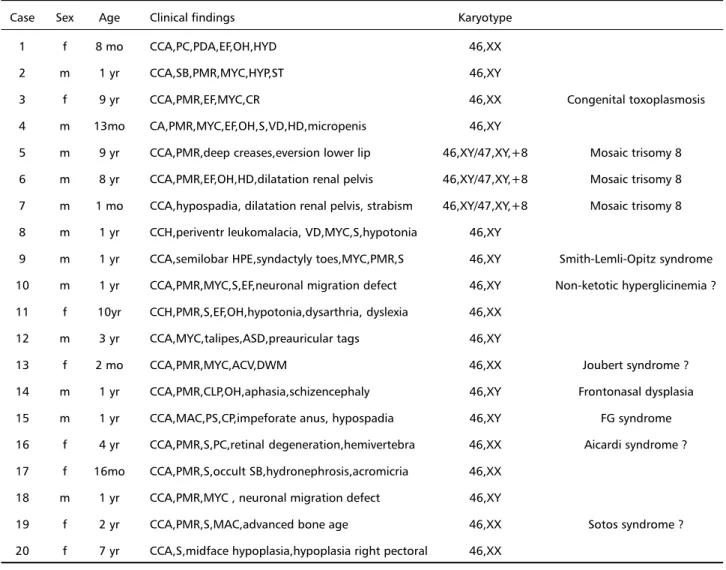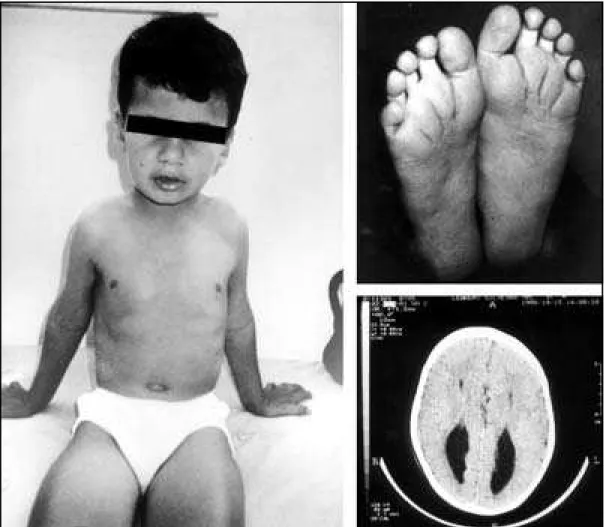Arq Neuropsiquiatr 2002;60(2-B):382-385
CLINICAL, NEUROIMAGING AND
CYTOGENETIC FINDINGS IN 20 PATIENTS
WITH CORPUS CALLOSUM DYSGENESIS
Anna Cláudia Evangelista dos Santos
1, Sônia Regina Midleton
2,
Regina Lugarinho Fonseca
2, Suely Rodrigues dos Santos
1,
Juan Clinton Llerena Jr.
3, Fernando Regla Vargas
4ABSTRACT - Twenty children with corpus callosum agenesis or hypoplasia were evaluated under a standardized investigation protocol. Psychomotor retardation, seizures, and craniofacial anomalies were the most prominent findings. There were three cases of chromosomal anomalies, all of them representing trisomy of chromosome 8.
KEY WORDS: corpus callosum agenesis, chromosomal anomaly, trisomy 8.
Achados clínicos, citogenéticos e de neuroimagem em 20 pacientes com disgenesia do corpo caloso Achados clínicos, citogenéticos e de neuroimagem em 20 pacientes com disgenesia do corpo caloso Achados clínicos, citogenéticos e de neuroimagem em 20 pacientes com disgenesia do corpo caloso Achados clínicos, citogenéticos e de neuroimagem em 20 pacientes com disgenesia do corpo caloso Achados clínicos, citogenéticos e de neuroimagem em 20 pacientes com disgenesia do corpo caloso
RESUMO - Vinte pacientes com disgenesia do corpo caloso foram avaliados através de um protocolo padro-nizado. Retardo neuropsicomotor, convulsões e dismorfias faciais foram os achados mais proeminentes. Três casos de anomalia cromossômica foram observados, todos representados por trissomia do cromossomo 8.
PALAVRAS-CHAVE: disgenesia do corpo caloso, anomalia cromossômica, trissomia 8.
Agenesis of the corpus callosum represents a dis-organization of the brain architecture which results from partial or total failure of the “callosal” comisural fibers to cross the midline and form connections in the neocortex between the two cerebral hemisphe-res. In the absence of other recognized malforma-tions of the central nervous system (CNS) the agene-sis of corpus callosum may be asymptomatic, or asso-ciated with seizures or other symptoms that carac-terize a syndrome of interhemispheric disconnec-tion1-4. The associated malformations usually
deter-mine the clinical syndromes5. Other commonly
as-sociated findings are: mental retardation, learning disability, non-CNS congenital malformations and infantile spasms. Both corpus callosum agenesis or corpous callosum hypoplasia may be readily detected on magnetic resonance imaging (MRI), computer-ized tomography (CT) or ultrasonography (US)6-8.
The main purpose of this study is to characterize the most common clinical and cytogenetic associ-ated findings in a cohort of 20 children with dysge-nesis of the corpus callosum.
METHOD
Twenty children were recruited from two different ge-netics outpatient clinics (Centro de Genética Médica, Ins-tituto Fernandes Figueira, FIOCRUZ, and Hospital Univer-sitário Gafrée-Guinle, UNIRIO) located in Rio de Janeiro, Brazil. Each patient was submitted to a standardized evalu-ation protocol that included: neurologic evaluevalu-ation, neu-roimaging study, cytogenetic analysis and other special-ized evaluations according to each case. Both the design of the present study and the evaluation protocol had been previously approved by the local institutional ethics com-mittee.
RESULTS
The clinical, radiological and cytogenetic findings are summarized in Table 1. Complete agenesis of the corpus callosum (CCA) was present in 18 patients, whereas 2 patients presented with hypoplasia of the corpus callosum (CCH). One of the patients (Case 18) represents a familial instance of isolated CCA, with CCH present in the clinically unaffected father.
Seven patients presented with other associated CNS malformations, namely, porencephalic cyst (Case
Unidade de Genética e Biologia Molecular, CCBS, UNIRIO, Rio de Janeiro, RJ, Brazil: 1Physician; 2Associate Professor; 3Associate
Re-searcher, (Centro de Genética Médica, IFF, FIOCRUZ, Rio de Janeiro, RJ, Brazil ); 4Associate Professor, and Divisão de Genética, Instituto
Nacional do Câncer (INCa), Rio de Janeiro, RJ, Brazil.
Received 24 August 2001, received in final form 7 January 2002. Accepted 21 Janeiro 2002.
Arq Neuropsiquiatr 2002;60(2-B) 383
1), periventricular leukomalacia (Case 8), holoprosen-cephaly (Case 9), neuronal migration defect (Cases 10 and 18), Dandy-Walker malformation (Case 13), and schizencephaly (Case 14).
Psychomotor retardation and seizures were the most commonly associated symptoms, being present in 13/20 and 10/20 cases, respectively. The age of onset of the seizures varied between 5 days and 11 months. There was a tendency for the association of psychomotor retardation with an early age onset of seizures. Also, patients with CNS malformations tended to have earlier age of onset of seizures. There was no recurrent EEG pattern in the sample.
Among the craniofacial anomalies the most fre-quently observed were microcephaly (8 cases), epi-canthal folds (6 cases), ocular hypertelorism (4 cases), and macrocephaly (2 cases).
Other malformations found in the present sample
included visual deficit (3 cases), hearing impairment (2 cases), congenital heart defect (3 cases), and geni-tourinary anomalies (3 cases).
Three patients (Cases 5,6, and 7) presented with a chromosomal anomaly, namely, trisomy of chro-mosome 8 (Fig 1). The aneuploid lineage was detec-ted in peripheral lymphocytes in Cases 6 and 7, and only in fibroblasts in Case 5.
DISCUSSION
Corpus callosum dysgenesis (CCD) is a causally heterogeneous malformation that may present iso-lated or associated with a number of other anoma-lies. The failure in development of the corpus callo-sum may be related to different causes such as envi-ronmental (congenital toxoplasmosis and fetal al-cohol syndrome, for example), genetic or vascular anomalies9,10.
Table 1. Associated findings.
Case Sex Age Clinical findings Karyotype
1 f 8 mo CCA,PC,PDA,EF,OH,HYD 46,XX
2 m 1 yr CCA,SB,PMR,MYC,HYP,ST 46,XY
3 f 9 yr CCA,PMR,EF,MYC,CR 46,XX Congenital toxoplasmosis
4 m 13mo CA,PMR,MYC,EF,OH,S,VD,HD,micropenis 46,XY
5 m 9 yr CCA,PMR,deep creases,eversion lower lip 46,XY/47,XY,+8 Mosaic trisomy 8 6 m 8 yr CCA,PMR,EF,OH,HD,dilatation renal pelvis 46,XY/47,XY,+8 Mosaic trisomy 8 7 m 1 mo CCA,hypospadia, dilatation renal pelvis, strabism 46,XY/47,XY,+8 Mosaic trisomy 8 8 m 1 yr CCH,periventr leukomalacia, VD,MYC,S,hypotonia 46,XY
9 m 1 yr CCA,semilobar HPE,syndactyly toes,MYC,PMR,S 46,XY Smith-Lemli-Opitz syndrome 10 m 1 yr CCA,PMR,MYC,S,EF,neuronal migration defect 46,XY Non-ketotic hyperglicinemia ? 11 f 10yr CCH,PMR,S,EF,OH,hypotonia,dysarthria, dyslexia 46,XX
12 m 3 yr CCA,MYC,talipes,ASD,preauricular tags 46,XY
13 f 2 mo CCA,PMR,MYC,ACV,DWM 46,XX Joubert syndrome ?
14 m 1 yr CCA,PMR,CLP,OH,aphasia,schizencephaly 46,XY Frontonasal dysplasia 15 m 1 yr CCA,MAC,PS,CP,impeforate anus, hypospadia 46,XY FG syndrome 16 f 4 yr CCA,PMR,S,PC,retinal degeneration,hemivertebra 46,XX Aicardi syndrome ? 17 f 16mo CCA,PMR,S,occult SB,hydronephrosis,acromicria 46,XX
18 m 1 yr CCA,PMR,MYC , neuronal migration defect 46,XY
19 f 2 yr CCA,PMR,S,MAC,advanced bone age 46,XX Sotos syndrome ? 20 f 7 yr CCA,S,midface hypoplasia,hypoplasia right pectoral 46,XX
384 Arq Neuropsiquiatr 2002;60(2-B)
In our study group microcephaly (8/20) was more common than macrocephaly (2/20), although a simi-lar study observed a higher frequency of macroceph-aly among children with CCD11. The most commonly
associated clinical findings in our group were sei-zures and psychomotor retardation. This, however, may reflect a bias towards the ascertainment of only the more severely affected cases, whereas the asymp-tomatic or mildly affected cases would be missed. The most commonly associated dysmorphies in our group were ocular hypertelorism and epicanthal folds.
Genetic causes of CCD include chromosomal as well as mendelian disorders9,12,13. Among the
cytoge-netic anomalies in our study group, mosaic trisomy 8 was observed in three cases (Cases 5,6,7). Trisomy 8 is a relatively common aneuploidy, with an inci-dence of one in 25000 births. There is a predominan-ce of affected males, with a male to female ratio of five to one12. The majority of cases are mosaics,
fre-quently observed only in fibroblasts. Also, there is a
selection against aneuploid lymphocytes, so that tri-somic cells are less frequent in peripheral blood cultu-res as the age increases. For this reason fibroblast cultures should be performed if there is clinical sus-picion of trisomy 8.
Patients with CCD associated with psychomotor retardation and/or seizures should be classified syn-dromically, due to the etiologic heterogeneity of these conditions. The clinical evaluation of these pa-tients should include neurological examination and a thourough search for associated dysmorphies, es-pecially on the face and extremities. Due to a num-ber of inborn errors of metabolism that may present with CCD, a metabolic work up should also be per-formed. The neuroimaging methods usually availa-ble (MRI, CT in any age, and US in babies and in-fants with open anterior fontanelle) may identify ca-ses of CCD even antenatally, allowing for the prena-tal diagnosis of this condition14,15. Due to the high
frequency of mosaic trisomy 8 in children with CCD, a significant number of metaphases should ideally
Arq Neuropsiquiatr 2002;60(2-B) 385
be counted in order to exclude a mosaic trisomic lineage. In cases where a clinical suspicion of trisomy 8 is present, a fibroblast culture should be performed in order to establish the diagnosis.
The establishment of a nosologic diagnosis clari-fies the etiology of the disease, providing more effi-cient genetic counseling and treatment options.
REFERENCES
1. Barkovich A, James N. Formation, maturation, and disorders of the brain neocortex. Am J Neuroradiol 1992;13:423-446.
2. Agliotti S, Tassinari G, Berlucchi G. Spatial stimulus-response compat-ibility in callosotomy patients and subjects with callosal agenesis. Neurosci Biobehav Rev 1996;20:623-629.
3. Nieto-Barrera M, Rodriguez-Criado G, Carballo M. Corpus callosum agenesis and epileptic seizures. Rev Neurol (Barc) 1999;28:6-13. 4. Volpe J. Neurology of the newborn. 3.Ed. Philadelphia: Saunders, 1995. 5. Adams RD. Neurologic disorders caused by lesions in particular parts of the cerebrum. In Principles of neurology. 6.Ed. New York: McGraw-Hill, 1996:111-115.
6. Larcen PD, Osborn AG. Computed tomographic evaluation of corpus callosum agenesis and malformations. J Computed Tomograph 1982;6:225-230.
7. Okuno T, Matsuo M, Higa T, Hattori H. Neuroimaging in neuronal migration disorders. No To Hattatsu 1997;29:23-128.
8. Maheut-Lourmiere J, Paillet C. Prenatal diagnosis of anomalies of the corpus callosum with ultrasound: the echographist’s point of view. Neurochirurgie 1998;44:85-92.
9. Dobyns WB. Absence makes the search grow longer. Am J Hum Genet 1996;58:7-16.
10. Becker PF. Cytomegaly and central nervous system abnormalities: re-port of two cases associated with agenesis of the corpus callosum and cystic encephalopathy. Arq Neuropsiquiatr 1975;33:1-20.
11. Lacey DJ. Agenesis of the corpus callosum: clinical features in 40 chil-dren. Am J Dis Child 1985;139:953-957.
12. Jones KL. Smith’s recognizable patterns of human malformations. 5.Ed. Philadelphia: Saunders, 1998.
13. Koul R, Chacko A, Sankhla DK. Corpus callosum agenesis. Saudi Med J 2001;22:22-25.
14. Brisse H, Sebag G, Fallet C, et al. Prenatal MRI of corpus callosum agen-esis: study of 20 cases with neuropathological correlations. J Radiol 1998;79:659-666.

